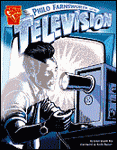Through the Looking Glass Children's Book Reviews
Philo Farnsworth and the Television
Illustrator: Keith Tucker
Nonfiction Graphic Novel Series
For ages 7 to 10
Capstone Press, 2006 ISBN: 978-0736864879
Philo Farnsworth was thrilled when his family moved to a farm in Ohio in 1918 where there was electricity. Though he was only twelve he was quickly experimenting with electricity and putting it to all kinds of new uses at his parent’s farm. In his spare time he read about what scientists were doing with electricity and he was particularly intrigued by the idea of sending pictures using electricity. At this time people were dependent on movies, newspapers, and the radio for news and information and the idea of being able to see as well as hear and read about news was fascinating to Philo.
When he was just thirteen he began to work on an invention that could send pictures using electricity. He asked his science teacher at school for help but the teacher knew even less about electricity than Philo did. At last Philo had a breakthrough and came up with an idea of how his invention might work. He called his machine a “television” and when he was nineteen and had a lab in San Francisco, he began to build the machine. The process was difficult because Philo had to build many of the parts himself but on September 7th, 1927 he gave a demonstration of his first electronic television transmission.
1934 Philo was able to give a demonstration to the public. Thousands came to see images on Philo’s television screen. Unfortunately this triumph was marred by battles between Philo and his competitors over who controlled the patents for the electronic television. RCA insisted that their scientists were the ones who first came up with the idea for an electronic television but Philo was able to prove that he was the one who came up the idea when he was still a high school student. Unfortunately for Philo Farnsworth RCA still had the money and the power in business and it was RCA that brought the television into the homes of the American people and not Philo’s company.
This excellent title in the Graphic Library series tells the story of a man whose achievements are not always given the recognition they deserve. An excellent text set in a graphic rich format presents Philo Farnsworth’s story in an engaging way which even reluctant readers will find attractive.




